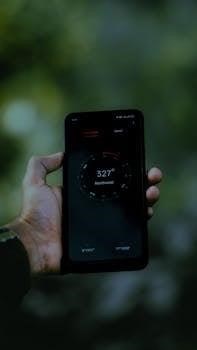
Bosch Ascenta User Guide⁚ A Comprehensive Overview
Welcome to your comprehensive guide to the Bosch Ascenta dishwasher! This guide provides an overview of the Ascenta series, offering valuable information about operation, maintenance, and troubleshooting. Whether you’re a new owner or seeking to optimize your dishwasher’s performance, this resource will assist you with ease.

Understanding Your Bosch Ascenta Dishwasher
The Bosch Ascenta dishwasher series is designed to provide efficient and reliable dishwashing performance; Understanding the features and functionality of your Ascenta dishwasher is key to maximizing its lifespan and ensuring sparkling clean dishes every time. These dishwashers are known for their quiet operation, energy efficiency, and user-friendly design. Familiarize yourself with the components, including the spray arms, filter system, and adjustable racks.
The Ascenta models often include features like multiple wash cycles, adjustable racks, and a sanitize option. Knowing how to properly load the dishwasher, select the appropriate cycle, and maintain the unit will contribute to its optimal performance. This section will guide you through the core aspects of your Ascenta dishwasher, helping you to understand how it works and how to get the best results. By taking the time to understand your dishwasher, you’ll be able to address any issues that may arise and keep your appliance running smoothly for years to come; Reference your model’s specific manual for detailed information.
Initial Setup and Installation
Proper initial setup and installation are crucial for the optimal operation of your Bosch Ascenta dishwasher. Before you begin, carefully read the installation instructions provided with your specific model. Ensure that you have all the necessary tools and components, including water supply lines, drain hoses, and electrical connections. Verify that the installation location meets the required specifications, such as adequate space and proper plumbing and electrical outlets.
The dishwasher must be grounded to a metal, permanent wiring system, or an equipment grounding conductor should be run with the circuit conductors. Connect it to the equipment grounding terminal on the dishwasher. It is recommended to hire a qualified plumber and electrician to perform the installation to ensure compliance with local codes and regulations. After installation, run a test cycle to check for leaks and proper operation. Carefully inspect all connections to prevent water damage. Proper setup ensures long-term performance and prevents potential issues down the line. Always refer to the official installation manual for your specific Ascenta model.
Control Panel and Program Selection
Understanding the control panel of your Bosch Ascenta dishwasher is essential for efficient operation. The control panel typically features buttons or touch controls to select various wash programs and options. Familiarize yourself with the different program settings, such as AutoWash, Heavy, Normal, and Delicate. Each program is designed for specific types of loads and soil levels.
The control panel will also include indicators for rinse aid levels, cycle status, and error codes. Many models also have additional options like Sanitize, Half Load, or Extra Dry. To select a program, press the corresponding button or touch the desired setting on the panel. The display will usually indicate the selected program and estimated cycle time. Some models also offer a delay start function, allowing you to schedule the dishwasher to run at a later time. Always refer to your user manual for the exact layout and functions of your specific Ascenta model’s control panel. Proper program selection ensures optimal cleaning performance and energy efficiency for every load.
Loading the Dishwasher Effectively

Efficiently loading your Bosch Ascenta dishwasher is critical for achieving optimal cleaning results. Start by scraping off large food particles before loading dishes. Avoid pre-rinsing, as modern dishwashers are designed to handle food residue. Place items strategically in the racks to ensure water and detergent can reach all surfaces.
In the lower rack, position larger items like pots, pans, and serving dishes, facing inwards and downwards. Ensure that items don’t block the spray arm’s rotation. The upper rack is ideal for cups, glasses, and smaller bowls. Utilize the adjustable rack feature to accommodate taller items. Silverware should be loaded into the utensil basket with alternating pieces facing up and down to prevent nesting. Avoid overloading the dishwasher, as this can hinder proper cleaning. Ensure that delicate items are securely placed to prevent damage during the wash cycle. Following these guidelines will help maximize the cleaning performance of your Bosch Ascenta dishwasher.

Detergent and Rinse Aid Usage
Proper detergent and rinse aid usage are essential for achieving sparkling clean and dry dishes with your Bosch Ascenta dishwasher. Always use detergents specifically formulated for dishwashers, and avoid using hand soap, which can create excessive suds and damage the appliance. Follow the detergent manufacturer’s instructions for the correct amount to use, as overloading can leave residue on dishes, while underloading may result in inadequate cleaning.
Rinse aid helps to reduce water surface tension, allowing water to sheet off dishes and prevent spotting and streaking. Fill the rinse aid dispenser according to the dishwasher’s manual, and adjust the dosage setting if needed to achieve optimal drying results. Regularly check the rinse aid level and refill as necessary. Using the correct amount of detergent and rinse aid will ensure your dishes are clean, dry, and free from unsightly water spots. Experiment with different detergent brands to find one that works best with your water hardness.
Maintenance and Cleaning
Regular maintenance and cleaning are vital to keep your Bosch Ascenta dishwasher performing optimally and extending its lifespan. Start by cleaning the filters regularly, as a clogged filter can reduce cleaning performance. Remove the lower spray arm and check for any blockages, rinsing it under running water to clear debris; Wipe down the dishwasher’s interior with a damp cloth and a mild cleaning solution to remove food particles and buildup.
To eliminate odors and mineral deposits, run an empty cycle with a dishwasher cleaner or a cup of white vinegar. Pour the vinegar into a dishwasher-safe container on the top rack or directly into the detergent dispenser. Clean the door seals with a damp cloth to prevent leaks and ensure a tight seal. Periodically inspect the spray arms for damage and replace them if necessary. By following these maintenance and cleaning tips, you can keep your Bosch Ascenta dishwasher in excellent condition, ensuring reliable performance and sparkling clean dishes for years to come.
Troubleshooting Common Issues
Encountering issues with your Bosch Ascenta dishwasher can be frustrating, but many common problems have simple solutions. If your dishwasher isn’t starting, check the power supply and ensure the door is securely closed. If dishes aren’t getting clean, verify that the spray arms are rotating freely and not blocked by dishes. Insufficient detergent or incorrect loading can also affect cleaning performance.
If the dishwasher is leaking, inspect the door seal for damage and ensure the dishwasher is level. A clogged drain can cause water to remain in the dishwasher after a cycle; clean the filter and check the drain hose for obstructions. If you notice unusual noises, check for loose items or debris inside the dishwasher. For more complex issues, consult the user manual or contact Bosch customer service for assistance. By addressing these common problems systematically, you can often resolve issues quickly and keep your dishwasher running smoothly.
Understanding Error Codes

Bosch Ascenta dishwashers are equipped with a diagnostic system that displays error codes to help identify potential issues. These codes can provide valuable insight into the nature of the problem, allowing for quicker troubleshooting and resolution. Common error codes include those related to water supply, drainage, heating, and sensor malfunctions.
For example, an “E24” error code often indicates a clogged filter or drain hose. Consulting your user manual is crucial for interpreting specific error codes, as the meaning can vary depending on the model. The manual will provide steps to take to resolve the error. Some issues may be easily fixed by the user, such as cleaning a filter, while others may require professional assistance. Understanding error codes can save time and effort in diagnosing and resolving problems with your Bosch Ascenta dishwasher. If an error persists after troubleshooting, contacting Bosch customer service or a qualified technician is recommended.
Adjusting Settings (Water Hardness, etc.)
The Bosch Ascenta dishwasher allows users to customize settings to optimize performance based on local water conditions and preferences. One important adjustable setting is water hardness. Hard water contains high levels of minerals like calcium and magnesium, which can leave spots and film on dishes. Adjusting the water hardness setting ensures the dishwasher uses the correct amount of salt to soften the water and prevent mineral buildup.
Consult your local water authority or test your water to determine its hardness level. Then, refer to your dishwasher’s manual for instructions on adjusting the water hardness setting accordingly. Other adjustable settings may include rinse aid dosage, which affects drying performance, and temperature settings for different wash cycles. Experimenting with these settings can help you achieve optimal cleaning and drying results while conserving water and energy. Always refer to your user manual for specific instructions on accessing and adjusting these settings on your particular Ascenta model.
Safety Precautions
Operating a Bosch Ascenta dishwasher safely requires adherence to several important precautions. Before using the appliance, carefully read and understand all instructions provided in the user manual. Ensure the dishwasher is properly grounded to a metal, permanent wiring system to prevent electrical shock. Avoid touching heating elements during or immediately after a wash cycle, as they can become extremely hot.
When loading and unloading the dishwasher, be cautious of sharp objects like knives and utensils. Place them in designated areas with the sharp ends pointing downwards to prevent injuries. Use only dishwasher-safe detergents and rinse aids, and keep them out of reach of children. Never attempt to repair or modify the dishwasher yourself; instead, contact a qualified technician for assistance. In case of any malfunction or unusual noise, immediately disconnect the power supply and seek professional help. Regularly inspect the dishwasher for any signs of damage, such as frayed cords or leaks, and address them promptly to ensure safe operation.
Available Ascenta Models and Manuals
The Bosch Ascenta series offers a range of dishwasher models designed to meet various needs and preferences. Some popular models include the SHE3AR75UC, SHE3AR55UC, and SHE3ARL2UC, each with unique features and specifications. These models often come in different finishes, such as stainless steel or black, to complement various kitchen styles.
To ensure optimal performance and safety, it’s essential to consult the user manual specific to your Ascenta model. Manuals provide detailed instructions on installation, operation, maintenance, and troubleshooting. You can typically download the manual from the Bosch website by entering the model number (E-NR) found on the appliance’s type plate. Manuals are available in multiple languages, including English, to cater to a wider audience. Additionally, resources like Sears Parts Direct offer access to manuals and parts diagrams for specific models, aiding in repairs and maintenance.